Sheep Analysing Breeding Performance.
Introduction
The ultimate aim of collecting data within FarmIT 3000 is to identify the best or worst performing animals within the business in order to improve business productivity. Of course farmers and breeders may have different ideas of exactly what the performance or look should be and therefore very different criteria to identify the best animal. Within FarmIT data may be analysed in a number of ways so identifying the best or worst often requires more than just clicking a single button.
We shall start with some very basic analysis based on factors we believe suitable for a commercial sheep enterprise and we shall look at the both ewe performance and rams separately.
Most of the work will be done using management groups and analysis tools. Analysis tools differ from the fixed reports in that they provide a configurable view, with built in filters, column sorting and additional statistics. Management groups allow us to create list of animals, both progeny and parents and use the lists for comparison.
For a guide to managements groups see FarmIT3000 Online Help
Analysis views give you direct access to the animal record by double clicking the animals tag and the ability to add animals to groups or create groups by selecting animals using shift, ctrl and single left click. You also have a popup menu by right click the list that provides addition menu option for example viewing progeny, adding to groups etc
For a guide to analysis views see the FarmIT3000 Online Help
Ewe Performance
Ewe performance may be split into two different areas, life time performance and seasonal performance. Live time performance looks at the number of lambs reared in the ewes life, seasonal performance looks at just one lambing season, from tupping through to weaning.
When analysing performance with only one or two lambing seasons life time performance is not really relevant.
We shall first define some basic commercial factors we may consider define the ewe’s performance. In this will we assume that the commercial enterprise wants to generate the maximum number of lambs from the minimum number of ewes, have the maximum number of lambs survive and grow at a suitable rate with or without extra feeding. With a bias to twins rather than singles.
So lets put the definition down
| 1. | The ewe has at least 1 Lambs |
| 2. | The ewe raises Lamb to a suitable weight at 8 – 10 weeks OLD |
NOTE – 8 – 10 Weeks
working with AHDB and SIGNET it is generally accepted that the ewes maternal ability – ( to raise the lamb(s)) is best measured at 8 weeks (56 days). At this age the lambs grow rate is more or less solely down to the EWE . After 56 days environmental factors start to come into play that may slow the development of the lamb as the lamb becomes more independent. Having said that in reality a lamb that is 35kg at 12 weeks old must have been very good at 8 weeks and a lambs that is only 15KG at 12 weeks was certainly not good at 8.
Seasonal Performance – Lambing Analysis and Weighing Analysis
Select from the main meny - Sheep / Analysis / Lambing Analysis
Lambing analysis provided information on ewes service, scanning, lambing and weaning, assuming all records have been entered. It is specifically usefull for identifying where individual disappear or reason why they do not have a lamb, for example abortions, prolapsed, scanned empty, died on the farm or simply did not have a recorded lambing record. You can hide or slect columns using the column select button - circled in red.
Lambing Analysis also has a Stats button ( small button top left with S on it highlight in blue) this displays the statistics for the filtered data ( i.E the data on screen) and covers numbers served scanned , lambed etc.
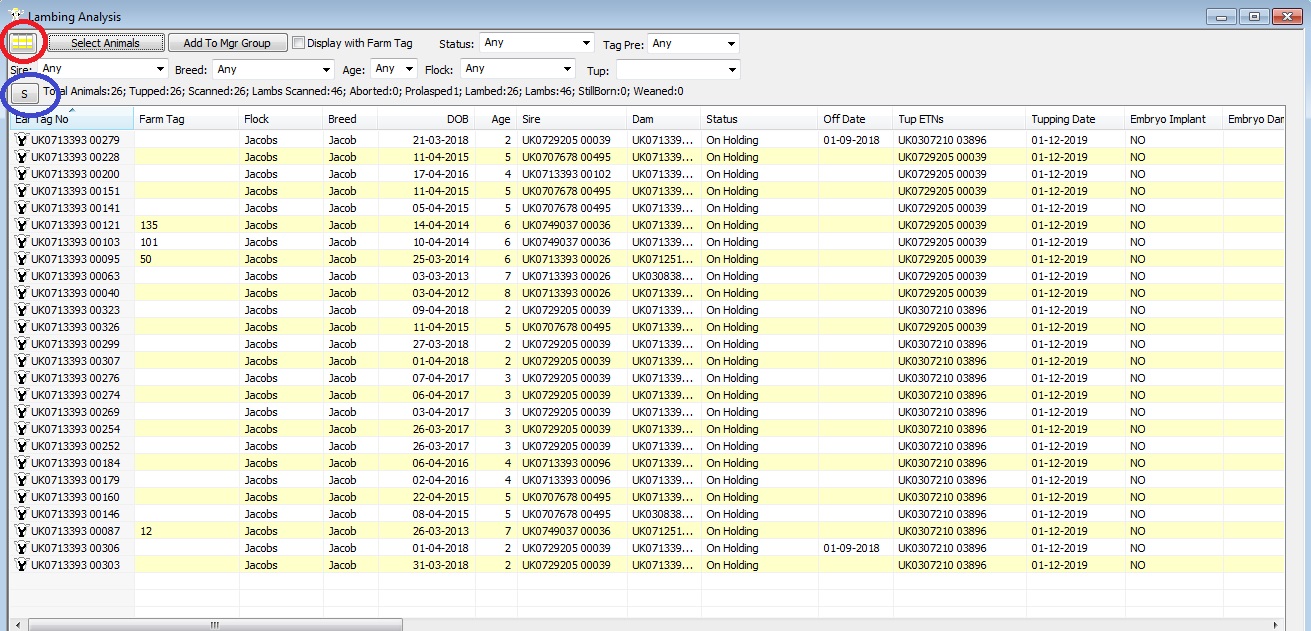
Weighing and Weighing Points
There are two primary ways to look at lamb weights, standard weight analysis and Weighing Point Analysis.
"Weighing Analysis"
Standard weight analysis “Weighing Analysis” is best used for looking at a group or year (top left) crop of animals in respect of there last weight and growth rate based on previous weight. Very good for looking at daily live weight gain (in blue) and comparing groups. We do not recommend it for ewe or ram performance. Again you can select columns (Green circle) and view stats ( Red Circle).
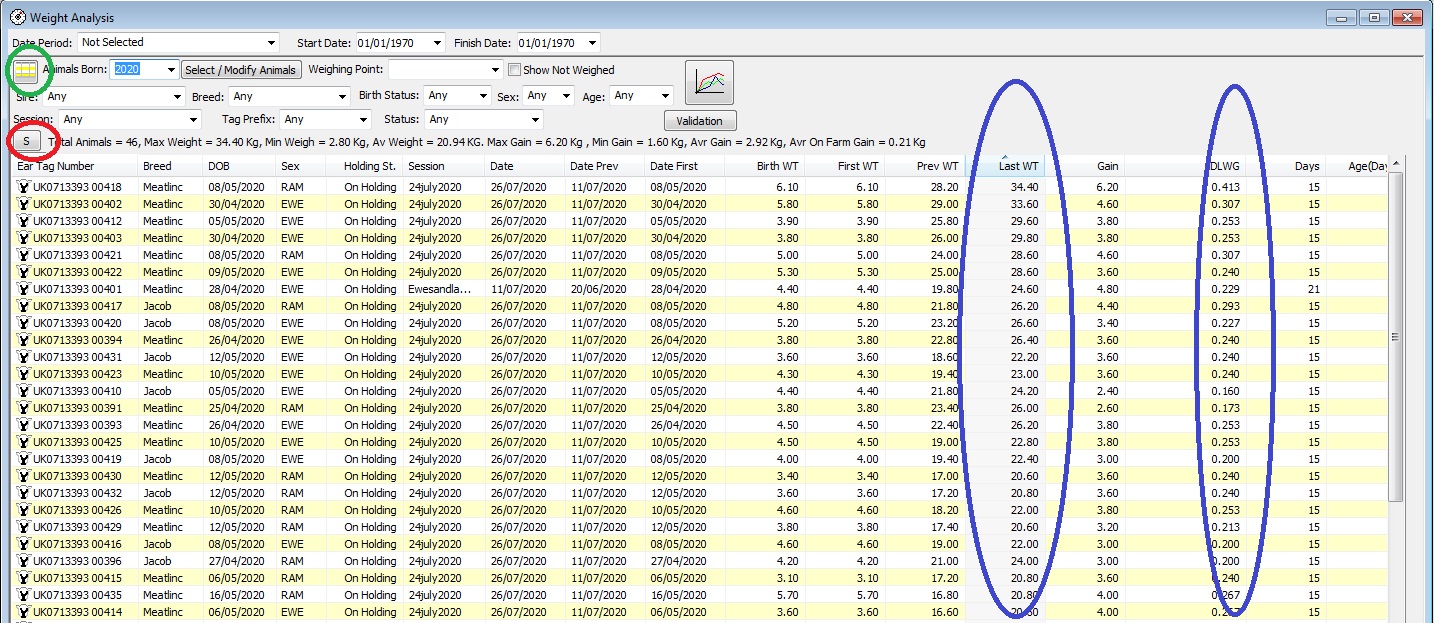
"Weighing Point Analysis"
When analysing the weight of lambs on at a specific age we define that age as a “Weighing Point”. The weighing point has a target age in days for example 90 days and a start and finish range in days for example 50 to 130 days.
The aim of the weighing point is to cater for the fact that if we record the lambs as they lamb each will have its own date of birth and we would expect lambs to be born over several weeks(except for AI) thus when weighing lambs (which we tend to do in groups) lambs are not likely to be the same age.
You may define your own weighing points, see the main sheep menu / Analysis / Live Weights and Analysis/ Weighing Points.
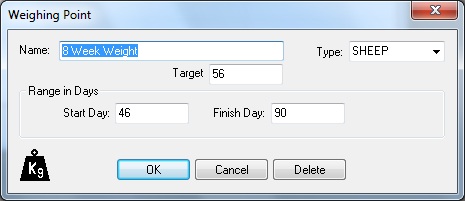
Weighing point analysis takes the weight records of the lambs and adjusts them to produce a weight based on the target day.
For example an animal weighed at 49 days old would have its weight adjusted to produce a weight for 56 days. This is achieved by calculating the animal approximate daily live weight gain a adjusting the actual recorded weight by addition or subtraction of the daily live weight gain.
The result ‘the adjusted weight’ is the weight of the lamb on the target date. This then allows us to rank the lambs by weight even if the lambs are different ages or were weighed on different days.
Weighing point analysis displayed the data as a line per lamb and ranks the lambs based on the adjusted weight. Like all analysis screen it has a stats button which may be used to identify the average weight and deviation. The stats also include options for SIRE, SEX , BREED, TAG PREFIX and SOURCE, So you can get instant access to individual SIRE statistics.
Finding The Best EWE
"Weighing Point Analysis Ewe Performance"
Select from the main menu - Sheep / Analysis / Weighing and Analysis / Weighing Point Analysis Ewe Performance
So assuming that the best ewe is defined as an animal having one or more lambs that live and are the heaviest! The best ewe can be simply arrived at from the weighing point analysis screen. However given this screen is listed by Lamb it can be difficult to rank the ewes so we use a slightly different view of the data ranked by the EWE.
The "Weighing Point Analysis Ewe Performance" tool gives us the same adjusted weights for each lamb but then combines them for the EWE, so a ewe having twins will show the total lambs and the total adjusted weight along side her body weight, BCS, age etc.
It also calculates the EWEs ‘Efficiency’ ratio of her weight to lamb weight raised.
The ewes are sorted by 'total lamb weight' so the one at the top IS the best ewe. The one at the bottom the WORST!. Note columns have been reduce to aid display.
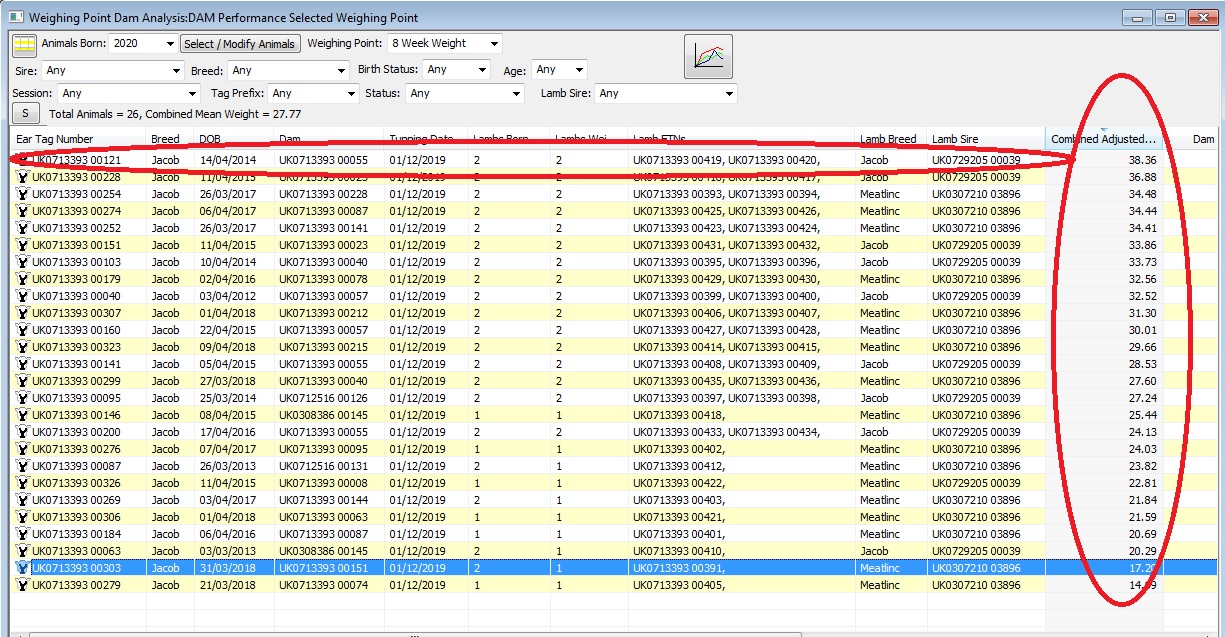
Fostering – the analysis view also takes into account fostering.
HOWEVER – weighing point analysis only takes into account animals that were actually weighed, so lambs that did not get weighed ( or were weighed outside the date range) do not appear in the analysis and therefore neither do their mothers.
Finding the BAD ones
Back to lambing analysis – Lambing analysis displays only ewes which have a tupping, scanning or lambing record. A ewe having none of these will NOT be displayed!
A tupping record does not have to include a specific sire but does define that the ewes WAS put to the tup. A EWE may have multiple tupping records she will only be counted ONCE.
Scanning is the obvious way to identify baron ewes and we would expect empty ewes to be sold prior to lambing on most commercial farms.
Any ewe with no lambing record was either not in the shed or field or we did not record the lambing event. This does not necessarily mean she did not have a lamb.
However using weighing point analysis it is possible to create a management group of ewes with lambs and take that group away from the group of all ewes to identify ewes with no weighed offspring. Thus identifying the bad performers that in theory did not raise a lambs.
Life Time Performance – EWE Breeding Analysis
Ewe breeding analysis provides data on successive seasons, providing the total number of lambs born, lost/died, sold , slaughtered and retained for each ewe. It also provides number of lambs for here entire maternal line, i.e the number raised by her mother, grand mother, great grand mother. Thus giving us a measure of prolificacy of the maternal line. Although this data is not relevant in the early years it is very useful for seeing the overall productivity of your ewes. Total numbers born and average litter size is highlited in green.
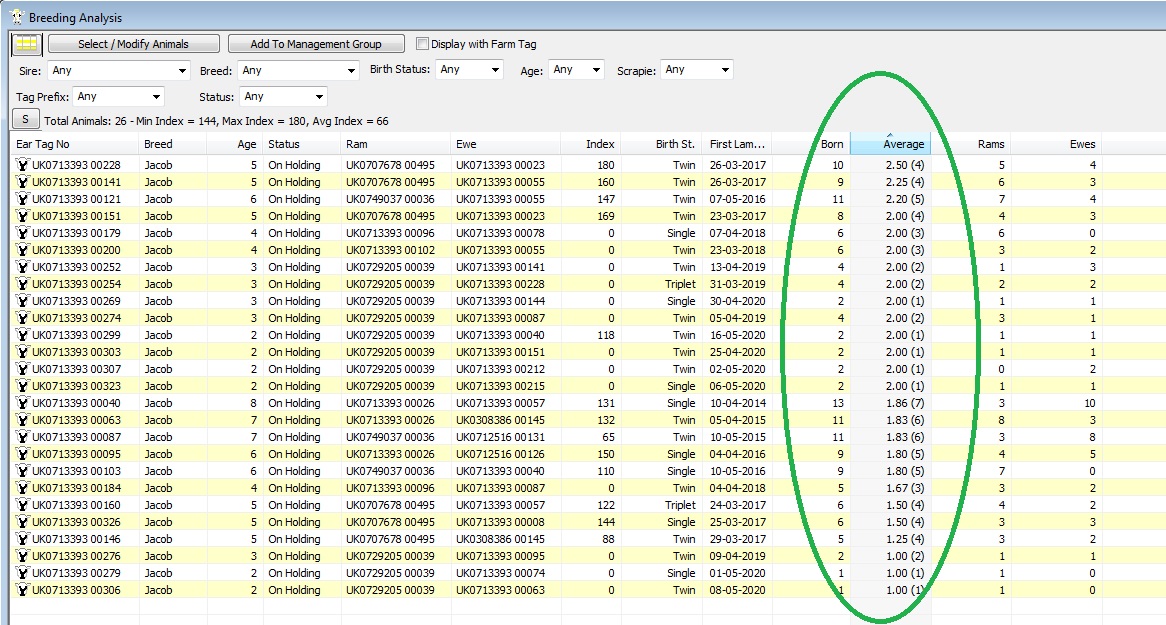
Mature Weight and Body Condition Scores
One final consideration on ewe performance is her size and condition. Quite obvisousy this does depend on breed so it is rather unfair to compare breed against breed. However the mature size and body condition of the ewe is a major factor when it come to her ability to conceive, give birth and raise a lamb. Even more so when it comes to twins. The "Ewe Mature Weight and BCS" analysis view allows us to see the variation in weight and condition in the breeding ewes over a period of time, for example from tupping to weaning.